Organizational Behavior: Personal Reflection and Case Studies
VerifiedAdded on 2023/06/11
|6
|1010
|263
Case Study
AI Summary
This document presents a case study focusing on organizational behavior, with personal reflections on leadership, conflict management, and fundraising challenges within a health outreach alliance and a second chance organization. The analysis identifies key issues such as conflicts between the Executive Director (ED) and team leaders, the need for improved management involvement, and financial sustainability concerns. Recommendations include consulting senior managers, building relationships with shareholders, and identifying potential donation sources. The reflection emphasizes the importance of short-term and long-term objectives, such as achieving self-reliance in social care and creating digital-based funds. The document also provides strategies for addressing substance abuse among women and ensuring the organizations' long-term success. Desklib offers a platform for students to access similar case studies and study resources.
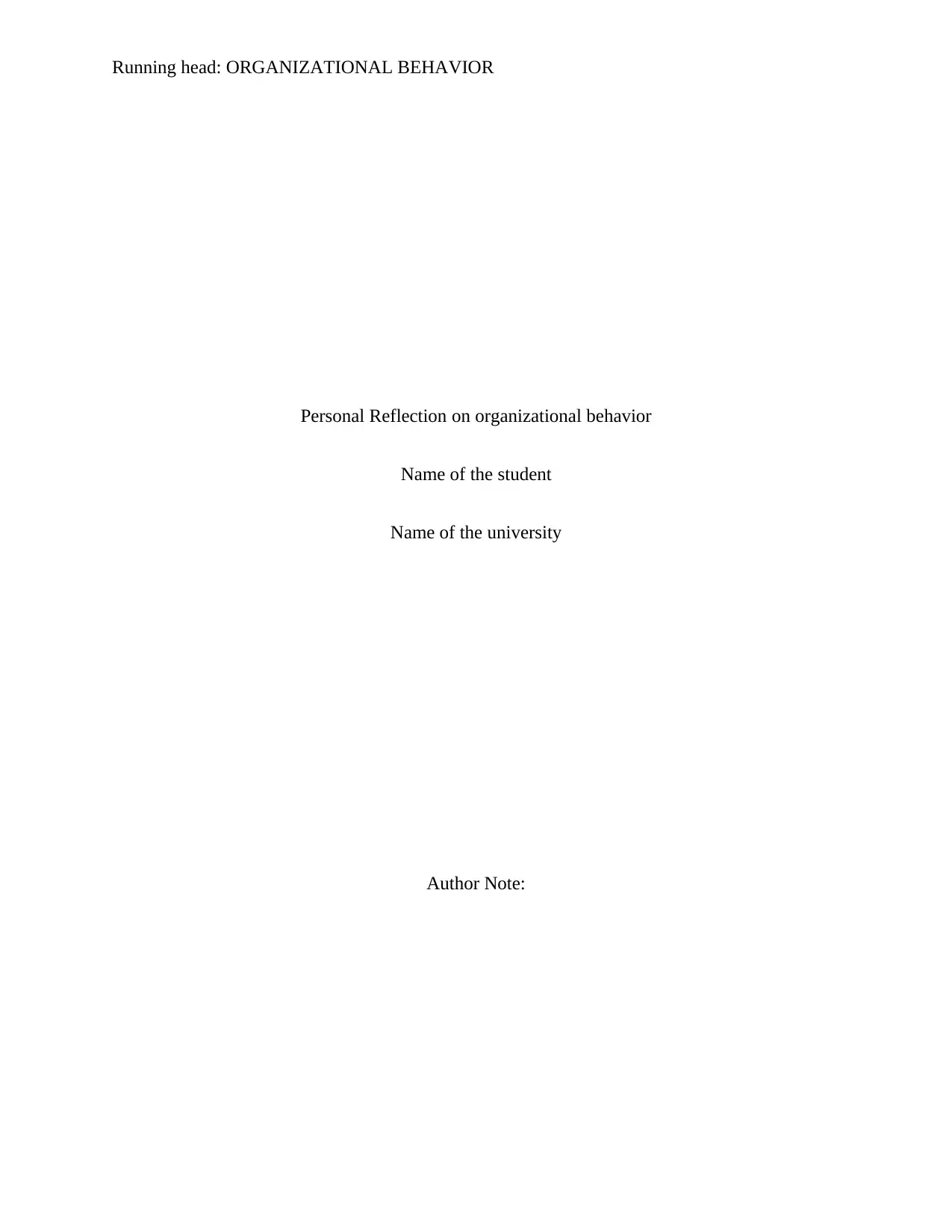
Running head: ORGANIZATIONAL BEHAVIOR
Personal Reflection on organizational behavior
Name of the student
Name of the university
Author Note:
Personal Reflection on organizational behavior
Name of the student
Name of the university
Author Note:
Paraphrase This Document
Need a fresh take? Get an instant paraphrase of this document with our AI Paraphraser
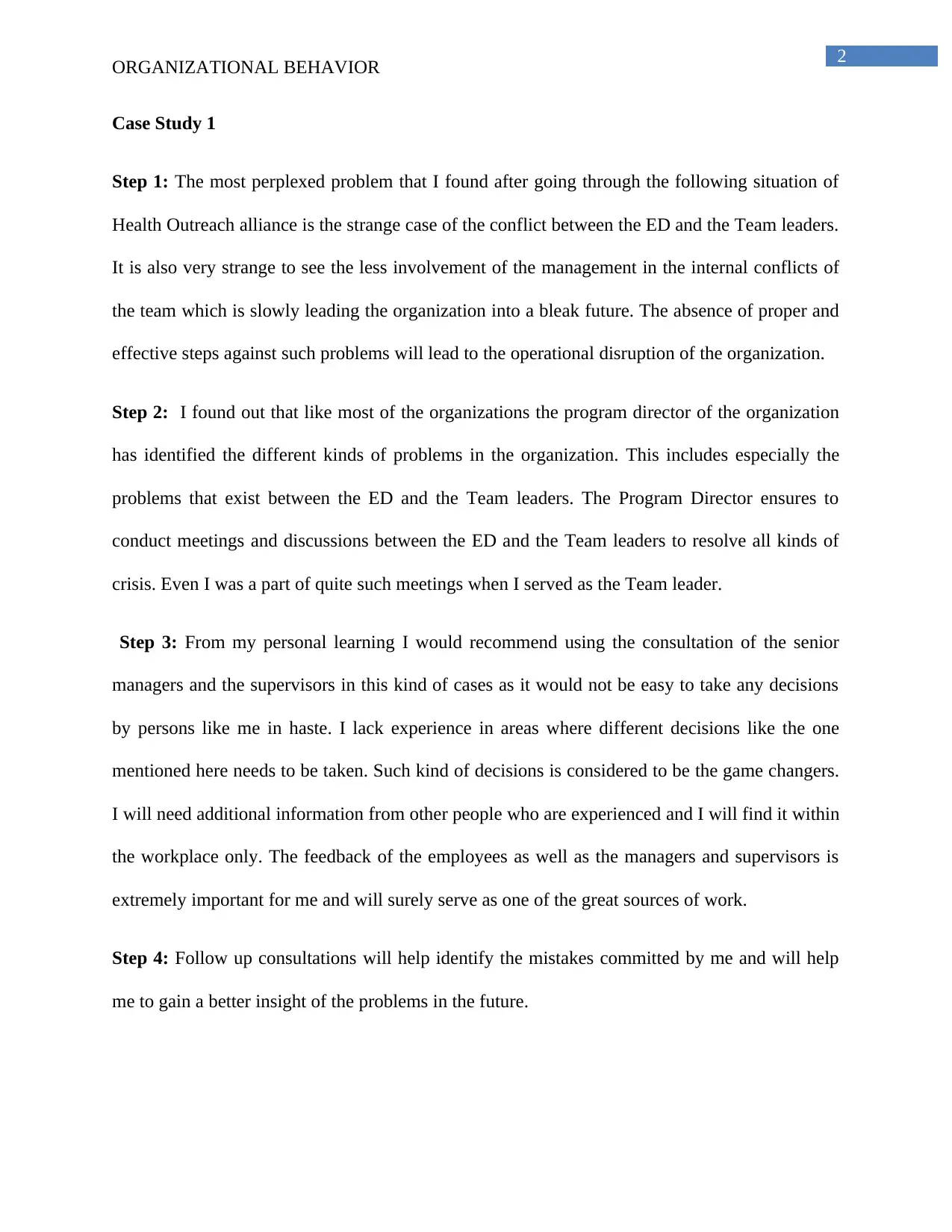
2
ORGANIZATIONAL BEHAVIOR
Case Study 1
Step 1: The most perplexed problem that I found after going through the following situation of
Health Outreach alliance is the strange case of the conflict between the ED and the Team leaders.
It is also very strange to see the less involvement of the management in the internal conflicts of
the team which is slowly leading the organization into a bleak future. The absence of proper and
effective steps against such problems will lead to the operational disruption of the organization.
Step 2: I found out that like most of the organizations the program director of the organization
has identified the different kinds of problems in the organization. This includes especially the
problems that exist between the ED and the Team leaders. The Program Director ensures to
conduct meetings and discussions between the ED and the Team leaders to resolve all kinds of
crisis. Even I was a part of quite such meetings when I served as the Team leader.
Step 3: From my personal learning I would recommend using the consultation of the senior
managers and the supervisors in this kind of cases as it would not be easy to take any decisions
by persons like me in haste. I lack experience in areas where different decisions like the one
mentioned here needs to be taken. Such kind of decisions is considered to be the game changers.
I will need additional information from other people who are experienced and I will find it within
the workplace only. The feedback of the employees as well as the managers and supervisors is
extremely important for me and will surely serve as one of the great sources of work.
Step 4: Follow up consultations will help identify the mistakes committed by me and will help
me to gain a better insight of the problems in the future.
ORGANIZATIONAL BEHAVIOR
Case Study 1
Step 1: The most perplexed problem that I found after going through the following situation of
Health Outreach alliance is the strange case of the conflict between the ED and the Team leaders.
It is also very strange to see the less involvement of the management in the internal conflicts of
the team which is slowly leading the organization into a bleak future. The absence of proper and
effective steps against such problems will lead to the operational disruption of the organization.
Step 2: I found out that like most of the organizations the program director of the organization
has identified the different kinds of problems in the organization. This includes especially the
problems that exist between the ED and the Team leaders. The Program Director ensures to
conduct meetings and discussions between the ED and the Team leaders to resolve all kinds of
crisis. Even I was a part of quite such meetings when I served as the Team leader.
Step 3: From my personal learning I would recommend using the consultation of the senior
managers and the supervisors in this kind of cases as it would not be easy to take any decisions
by persons like me in haste. I lack experience in areas where different decisions like the one
mentioned here needs to be taken. Such kind of decisions is considered to be the game changers.
I will need additional information from other people who are experienced and I will find it within
the workplace only. The feedback of the employees as well as the managers and supervisors is
extremely important for me and will surely serve as one of the great sources of work.
Step 4: Follow up consultations will help identify the mistakes committed by me and will help
me to gain a better insight of the problems in the future.

3
ORGANIZATIONAL BEHAVIOR
Case Study 2
Step 1: The most important components of the situation are the crisis in rising of annual funds of
$100,000.
The promise of granting at least $400,000 in the coming four years has led to the creation
of the following situation.
I saw that the most important risk to the organization is the chance of being bankrupt and
getting dissolved.
Step 2: The organization’s mission to take care of the rehab of women suffering from substance
abuse can be affected as because the management has to focus more on the assembling of funds
for the new partnership with Altruistic Foundation.
My personal learning has helped me to determine that the external environment of the
organization will have a significant problem as because the management will have to face
problems in controlling the different kinds of workforce and will also fail to address the social
and environmental problems.
The failure of the management of the organization to control the growing use of
substance and failure to provide the women a proper treatment will lead to the fall of the
organization.
Step 3: The CEO and other senior level managers must intervene into the problem to ensure a
fair deal.
ORGANIZATIONAL BEHAVIOR
Case Study 2
Step 1: The most important components of the situation are the crisis in rising of annual funds of
$100,000.
The promise of granting at least $400,000 in the coming four years has led to the creation
of the following situation.
I saw that the most important risk to the organization is the chance of being bankrupt and
getting dissolved.
Step 2: The organization’s mission to take care of the rehab of women suffering from substance
abuse can be affected as because the management has to focus more on the assembling of funds
for the new partnership with Altruistic Foundation.
My personal learning has helped me to determine that the external environment of the
organization will have a significant problem as because the management will have to face
problems in controlling the different kinds of workforce and will also fail to address the social
and environmental problems.
The failure of the management of the organization to control the growing use of
substance and failure to provide the women a proper treatment will lead to the fall of the
organization.
Step 3: The CEO and other senior level managers must intervene into the problem to ensure a
fair deal.
⊘ This is a preview!⊘
Do you want full access?
Subscribe today to unlock all pages.

Trusted by 1+ million students worldwide
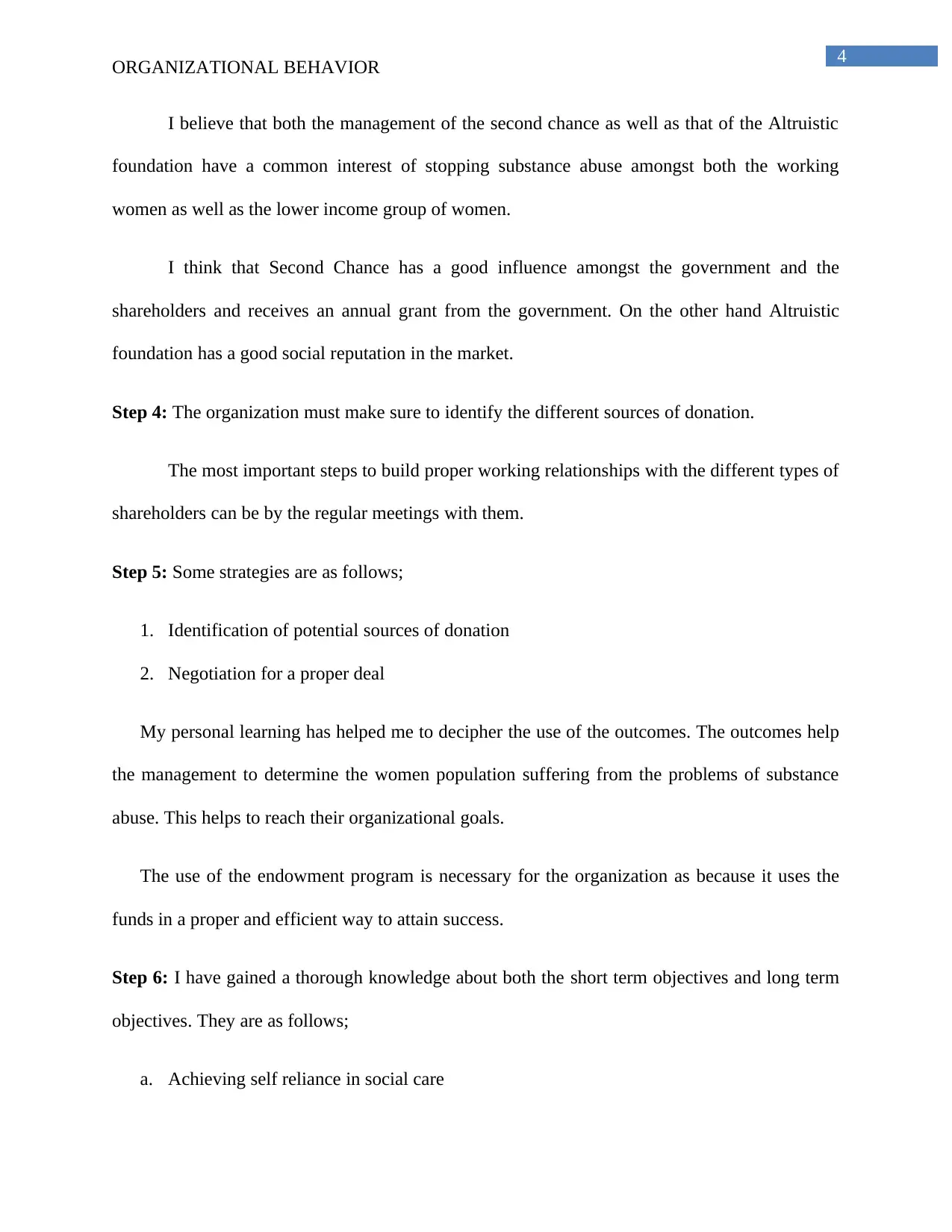
4
ORGANIZATIONAL BEHAVIOR
I believe that both the management of the second chance as well as that of the Altruistic
foundation have a common interest of stopping substance abuse amongst both the working
women as well as the lower income group of women.
I think that Second Chance has a good influence amongst the government and the
shareholders and receives an annual grant from the government. On the other hand Altruistic
foundation has a good social reputation in the market.
Step 4: The organization must make sure to identify the different sources of donation.
The most important steps to build proper working relationships with the different types of
shareholders can be by the regular meetings with them.
Step 5: Some strategies are as follows;
1. Identification of potential sources of donation
2. Negotiation for a proper deal
My personal learning has helped me to decipher the use of the outcomes. The outcomes help
the management to determine the women population suffering from the problems of substance
abuse. This helps to reach their organizational goals.
The use of the endowment program is necessary for the organization as because it uses the
funds in a proper and efficient way to attain success.
Step 6: I have gained a thorough knowledge about both the short term objectives and long term
objectives. They are as follows;
a. Achieving self reliance in social care
ORGANIZATIONAL BEHAVIOR
I believe that both the management of the second chance as well as that of the Altruistic
foundation have a common interest of stopping substance abuse amongst both the working
women as well as the lower income group of women.
I think that Second Chance has a good influence amongst the government and the
shareholders and receives an annual grant from the government. On the other hand Altruistic
foundation has a good social reputation in the market.
Step 4: The organization must make sure to identify the different sources of donation.
The most important steps to build proper working relationships with the different types of
shareholders can be by the regular meetings with them.
Step 5: Some strategies are as follows;
1. Identification of potential sources of donation
2. Negotiation for a proper deal
My personal learning has helped me to decipher the use of the outcomes. The outcomes help
the management to determine the women population suffering from the problems of substance
abuse. This helps to reach their organizational goals.
The use of the endowment program is necessary for the organization as because it uses the
funds in a proper and efficient way to attain success.
Step 6: I have gained a thorough knowledge about both the short term objectives and long term
objectives. They are as follows;
a. Achieving self reliance in social care
Paraphrase This Document
Need a fresh take? Get an instant paraphrase of this document with our AI Paraphraser
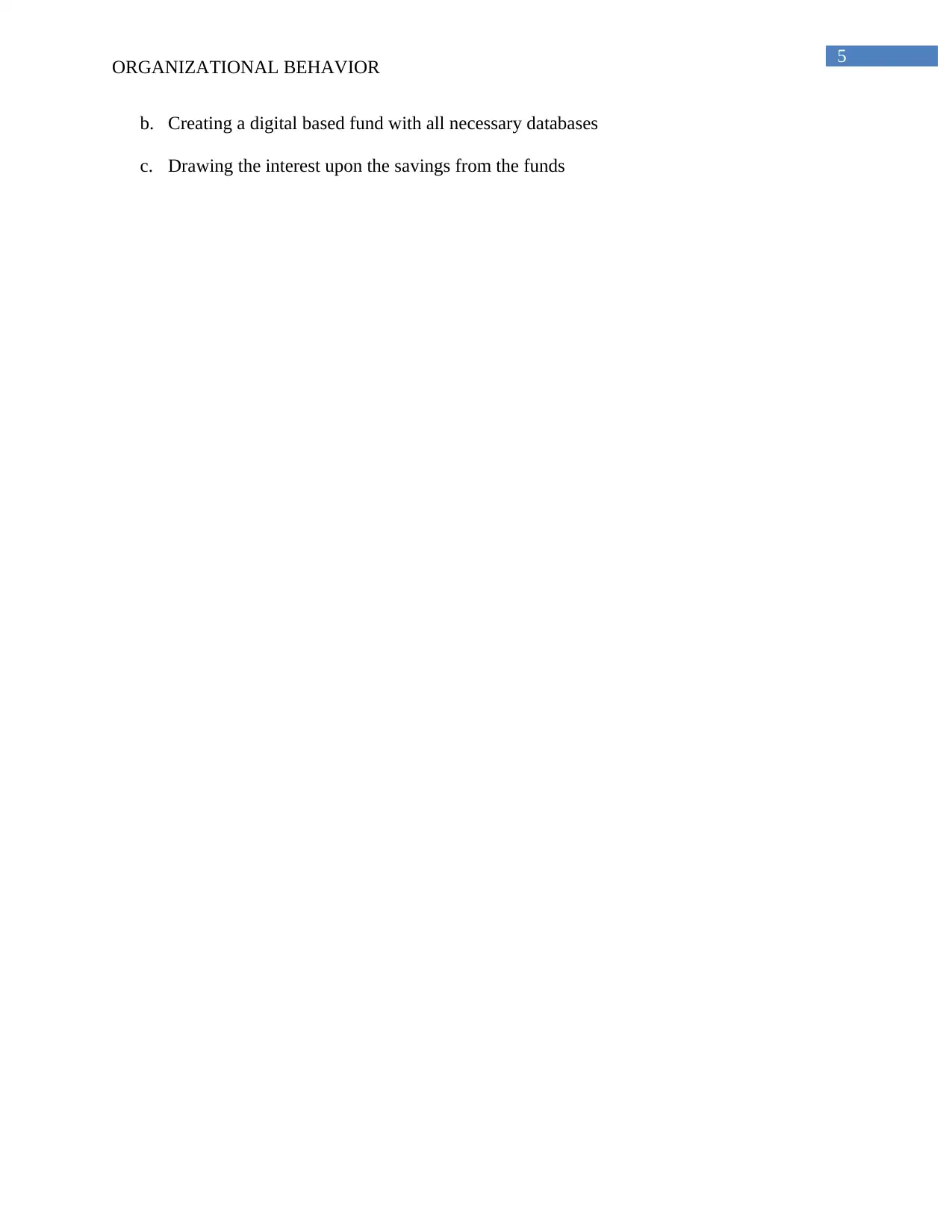
5
ORGANIZATIONAL BEHAVIOR
b. Creating a digital based fund with all necessary databases
c. Drawing the interest upon the savings from the funds
ORGANIZATIONAL BEHAVIOR
b. Creating a digital based fund with all necessary databases
c. Drawing the interest upon the savings from the funds
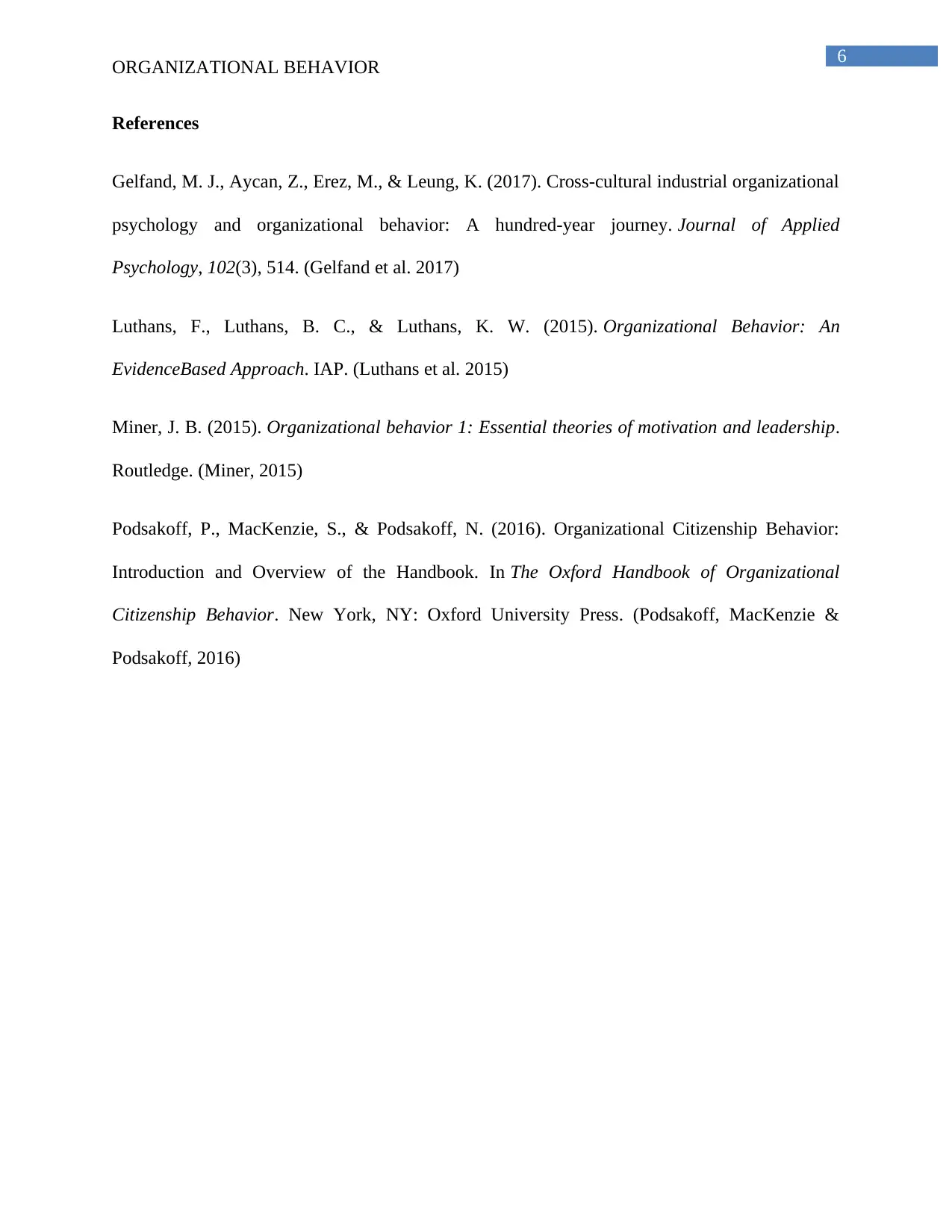
6
ORGANIZATIONAL BEHAVIOR
References
Gelfand, M. J., Aycan, Z., Erez, M., & Leung, K. (2017). Cross-cultural industrial organizational
psychology and organizational behavior: A hundred-year journey. Journal of Applied
Psychology, 102(3), 514. (Gelfand et al. 2017)
Luthans, F., Luthans, B. C., & Luthans, K. W. (2015). Organizational Behavior: An
EvidenceBased Approach. IAP. (Luthans et al. 2015)
Miner, J. B. (2015). Organizational behavior 1: Essential theories of motivation and leadership.
Routledge. (Miner, 2015)
Podsakoff, P., MacKenzie, S., & Podsakoff, N. (2016). Organizational Citizenship Behavior:
Introduction and Overview of the Handbook. In The Oxford Handbook of Organizational
Citizenship Behavior. New York, NY: Oxford University Press. (Podsakoff, MacKenzie &
Podsakoff, 2016)
ORGANIZATIONAL BEHAVIOR
References
Gelfand, M. J., Aycan, Z., Erez, M., & Leung, K. (2017). Cross-cultural industrial organizational
psychology and organizational behavior: A hundred-year journey. Journal of Applied
Psychology, 102(3), 514. (Gelfand et al. 2017)
Luthans, F., Luthans, B. C., & Luthans, K. W. (2015). Organizational Behavior: An
EvidenceBased Approach. IAP. (Luthans et al. 2015)
Miner, J. B. (2015). Organizational behavior 1: Essential theories of motivation and leadership.
Routledge. (Miner, 2015)
Podsakoff, P., MacKenzie, S., & Podsakoff, N. (2016). Organizational Citizenship Behavior:
Introduction and Overview of the Handbook. In The Oxford Handbook of Organizational
Citizenship Behavior. New York, NY: Oxford University Press. (Podsakoff, MacKenzie &
Podsakoff, 2016)
⊘ This is a preview!⊘
Do you want full access?
Subscribe today to unlock all pages.

Trusted by 1+ million students worldwide
1 out of 6
Related Documents
Your All-in-One AI-Powered Toolkit for Academic Success.
+13062052269
info@desklib.com
Available 24*7 on WhatsApp / Email
![[object Object]](/_next/static/media/star-bottom.7253800d.svg)
Unlock your academic potential
Copyright © 2020–2025 A2Z Services. All Rights Reserved. Developed and managed by ZUCOL.



![NURSING CASE STUDY: CRITICAL DISCUSSION - [University Name]](/_next/image/?url=https%3A%2F%2Fdesklib.com%2Fmedia%2Fimages%2Fqz%2F1da4b808cec246569d94252e4c61b71e.jpg&w=256&q=75)

